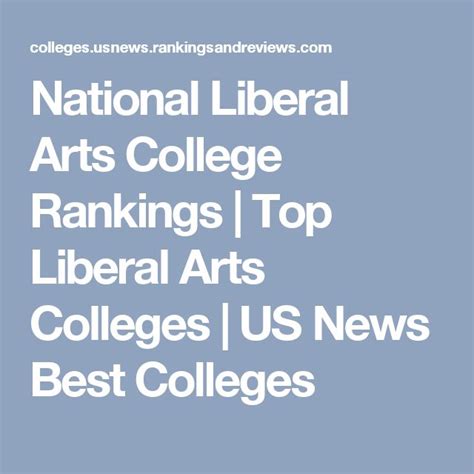The pursuit of higher education in the liberal arts has long been a cornerstone of academic tradition. These programs foster critical thinking, communication skills, and a broad understanding of the human condition. For prospective students seeking the pinnacle of liberal arts education, the US News & World Report’s annual rankings provide invaluable guidance.

Methodology and Key Considerations
The US News Liberal Arts College Rankings are meticulously compiled using a comprehensive set of criteria, including academic reputation, student selectivity, faculty resources, and financial stability. Institutions are evaluated and ranked based on peer assessments, standardized test scores, graduation rates, and endowment size.
Peer Assessments: Faculty and administrators from peer institutions rate the academic quality of each college based on their experience and knowledge. These assessments carry significant weight in determining overall rankings.
Student Selectivity: The average high school GPA, SAT/ACT scores, and acceptance rates of incoming students are considered to gauge the college’s ability to attract top academic talent.
Faculty Resources: The number of full-time faculty, student-to-faculty ratios, and faculty awards and honors are used to assess the quality of the teaching environment and faculty scholarship.
Financial Stability: The endowment size, fundraising success, and operating expenses of each college are examined to ensure financial stability and resources for faculty support, scholarships, and infrastructure.
Top-Performing Institutions
The 2023 US News Liberal Arts College Rankings paint a clear picture of excellence in liberal arts education. Leading the pack, Williams College in Massachusetts maintains its undisputed reign as the top-ranked institution. Other highly acclaimed colleges in the top 10 include:
- Amherst College
- Swarthmore College
- Wellesley College
- Pomona College
Undergraduate Experience and Career Prospects
Beyond the rankings, prospective students should carefully consider the specific undergraduate experience offered by each college. Factors such as class size, faculty accessibility, research opportunities, and student life are crucial in creating a fulfilling and transformative educational journey.
Liberal arts graduates enjoy a wide range of career prospects. The critical thinking and communication skills honed during their studies make them well-suited for careers in fields such as:
- Law
- Medicine
- Business
- Non-profit organizations
- Education
- Government
Common Mistakes to Avoid in College Selection
Navigating the college application process can be daunting. To ensure the best possible outcome, avoid these common mistakes:
-
Overemphasizing Rankings: While rankings are a valuable resource, they should not be the sole determining factor in your decision. Consider the specific needs and interests that align with your academic and career goals.
-
Ignoring Campus Climate: Visit the campus and interact with students and faculty to get a firsthand feel for the academic and social environment. Ensure that the college’s culture and values resonate with your own.
-
Not Researching Financial Aid: College expenses can vary significantly. Explore scholarship and financial aid opportunities to ensure affordability and minimize student debt.
-
Applying to Too Many Colleges: Focus on a manageable number of applications to avoid overwhelming yourself and maintain the quality of your essays and application materials.
Step-by-Step Approach to College Selection
To make a well-informed decision, follow this step-by-step approach:
1. Identify Interests and Goals: Determine your academic interests and career aspirations to narrow down your college search.
2. Research Potential Colleges: Gather information from websites, rankings, and college fairs to identify institutions that meet your criteria.
3. Visit Campuses: Experience campus life firsthand through guided tours, interactions with students and faculty, and attendance at academic events.
4. Explore Financial Aid: Contact the financial aid offices of your shortlisted colleges to inquire about scholarships, grants, and loans.
5. Apply Strategically: Tailor your application materials to each college’s requirements and highlight your strengths and qualifications.
Rankings and Resources
For further exploration, refer to the following resources:
- US News & World Report Liberal Arts College Rankings 2023
- College Board
- National Association for College Admission Counseling
Conclusion
The US News Liberal Arts College Rankings provide invaluable guidance in the pursuit of an exceptional undergraduate education in the liberal arts. By carefully considering the rankings, exploring undergraduate experiences, and avoiding common pitfalls, prospective students can make informed decisions that align with their unique needs and aspirations. The path to a transformative and fulfilling liberal arts journey begins with a thorough understanding of the options available.
